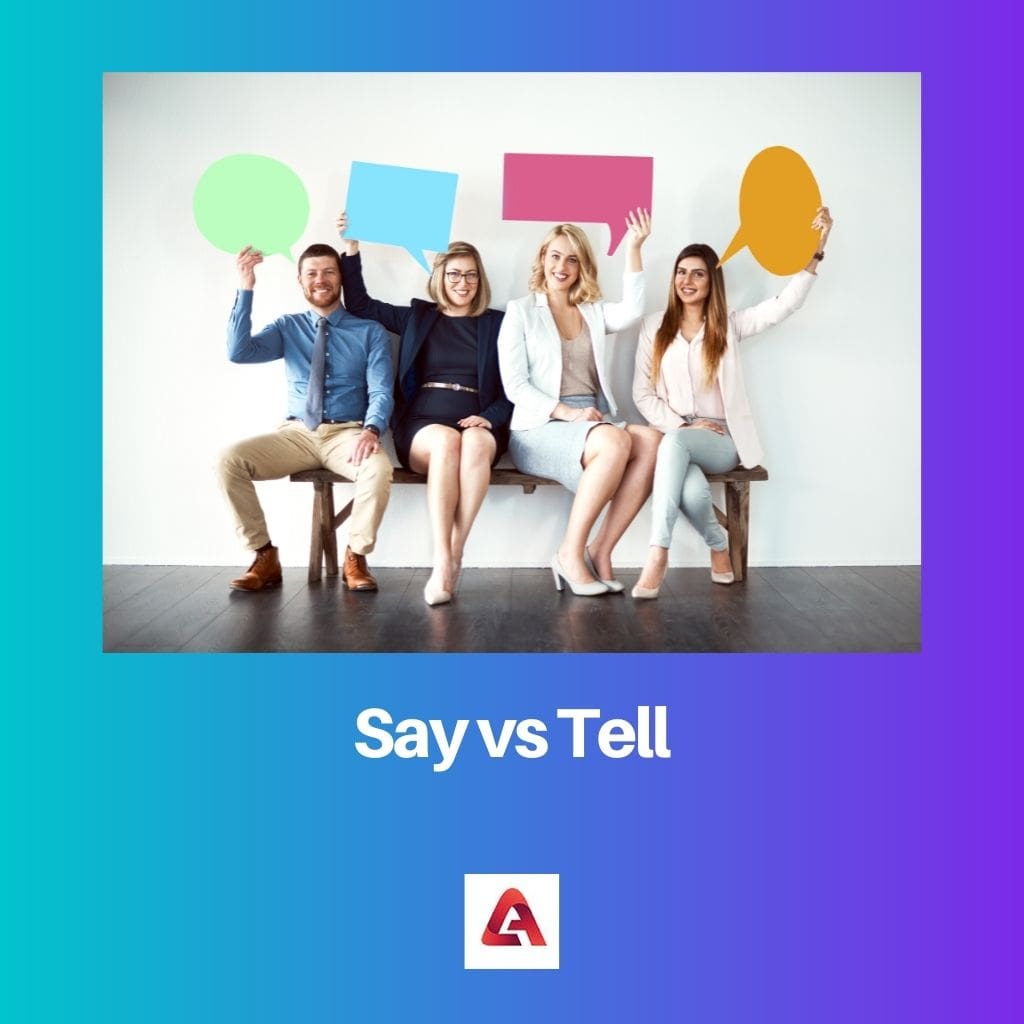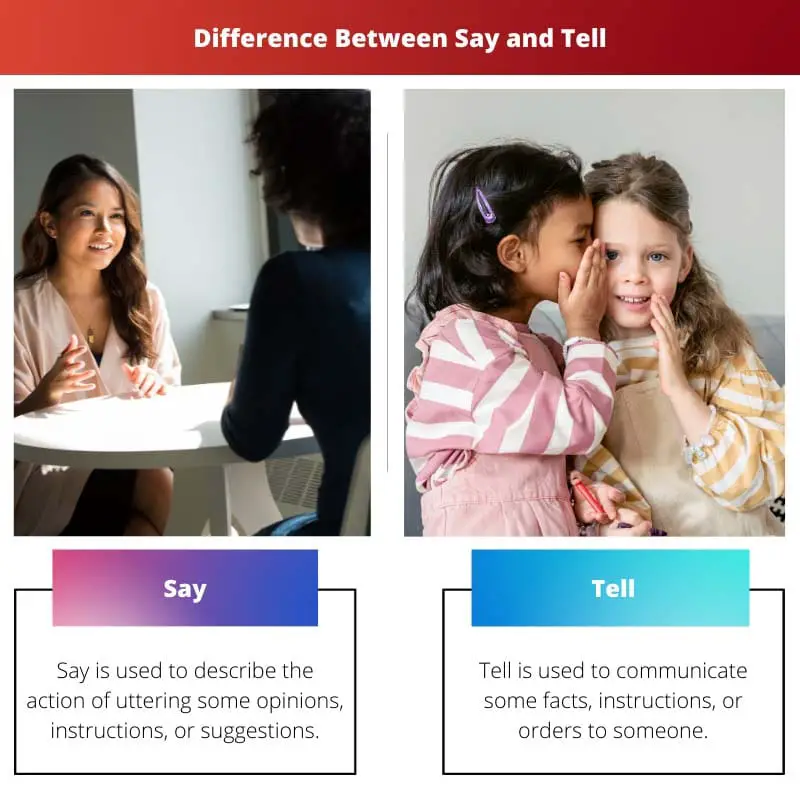While making sentences and while speaking, we may not realize specific syntax and subject-verb agreement errors. Still, these concepts become very important because of their ability to determine the proficiency of our English speaking and writing skills.
The recruiters and interviewers seek people who know complex and minutest subjects.
Say and Tell may have been used interchangeably sometimes, but it is essential to understand the difference in implications and contexts of use for the terms.
Key Takeaways
- “Say” and “tell” are both verbs used to convey spoken communication, but “say” focuses on the words or phrases spoken. In contrast, “tell” emphasizes informing or giving information to someone.
- “Say” can be used with or without a direct object and requires the use of quotation marks or the word “that” to introduce the statement, whereas “tell” requires a direct object, a person, to whom the information is being relayed.
- Both verbs are essential for describing various aspects of spoken communication, but their usage depends on the context and the sentence’s focus.
Say vs. Tell
The difference between Say and Tell is that Say is used to characterize the actions of uttering something, maybe an opinion or a suggestion. In contrast, Tell communicates instructions, orders, and advice. Different forms of Say can be used to quote dialogues and speeches and to make comments, while other forms of Tell can be used to show certainty and emphasis.

Comparison Table
| Parameter od Comparison | Say | Tell |
|---|---|---|
| Definition | Say describes the action of uttering some opinions, instructions, or suggestions. As a noun, it refers to someone’s right to give ideas, views, or recommendations. | Tell is used to communicate facts, instructions, or orders to someone. It is also a particular action in Poker, used as a noun. |
| Type of Speech | It can be used as a Verb, as a Noun, or as an Exclamation. | It can be used as a Verb or as a Noun (seldom) only. |
| Origin | It originated from Germanic. | It originated from Arabic. |
| Object | While using Say in a sentence, mentioning the object isn’t necessary. | While using Tell in a Sentence, the recognition of the object is necessary. |
| Sentence Structure | We always “Say Something” or “Say Something to Someone.” ‘To’ is used when an object is involved. | We always, “Tell someone something.” ‘To’ is not involved. |
| Usage | It can be used to quote someone, make comments, and report. | It is used to advise, order, or instruct |
| Special Phrases | ‘He said that, ‘‘I’ll say,’ and ‘One can’t Say.’ | ‘I can tell you,’ ‘No one can tell,’ or ‘I told you so.’ |
| Example | He said, “Everyone would be awarded for their work.” | He told me, “Exercise can make you fit.” |
When to Use Say?
Say is used in English Sentences and is a bit complex to understand. Different usages of Say must be understood to have proper syntax and correct sentence structure.
It can be used as a verb, an exclamation, or a noun. As a verb, three primary forms are, say, said, and saying. We always “ say something” or “say something to someone”; this is how the sentence structure goes.
Verb:
- As reporting verb: To utter something to convey information, suggestion, emotions, intention, or instruction; for example, He said the meeting was critical.
- With direct speech: To quote the sentences of someone. This is done when the speaker’s speech is conveyed to someone in the original form. For example: “Welcome,” he said.
- Of a text: To give out information and instructions. For example, The judgment said that he was guilty.
Noun: Used in the singular form: This means an opportunity to state one’s views and recommendations and an opportunity to influence community decisions and structures. For example, everyone must have an equal say in decision-making in an organization.
Exclamation: In informal North American English, to convey surprise or excitement towards a question or remark. For example, Say It!
There exist specific phrases with which only say and its forms are used. These are ‘have something to say for oneself,’ ‘go without saying,’ ‘What say you,’ ‘I’ll say,’ ‘One can not say,’ ‘not to say,’ ‘I wouldn’t say no,’ and ‘says you.’

When to Use Tell?
Tell is sometimes used interchangeably with say. It is important to note that similar words can have different meanings and specific contexts and sentence structures sometimes.
Tell can be used as a Noun or verb; the most common forms are telling, told, and tells. We always “tell someone something.” This is how the sentence structure must go.
Verb:
- As reporting verb: To communicate news, statements, or information to someone; for example, I told her the meeting minutes.
- With Object and Clause: For example, She told me you were coming.
- With Direct Speech and Clause: Example,“ Go away,” I told him.
- With two objects: For example, Everyone must be told the truth.
- To order, advise, or instruct someone: For example, I am telling you to exercise can make you fit.
- When no object: Disclosing information that is private and confidential. For example, “I promise, I won’t tell.”
With clause: To say something with emphasis and certainty. For example, I can tell you they’re hiding something.
Noun: An action in Poker to deceive an attempted betrayal.
It is also used with specific phrases like “as far as one can tell,” “I can tell you,” “tell me like it is,” “ Tell me about it,” and “I told you so.”

Main Differences Between Say and Tell
- To say means to utter something, maybe an opinion or a recommendation, while to tell means to communicate some information or instructions to someone.
- Say can be used as a verb, noun, or exclamation, while Tell can be used as a verb and noun (seldom) only.
- A sentence with Say may or may not mention the object, while mentioning the thing in sentences involving Tell is necessary and crucial.
- The sentence structure for Say would be either ‘Say Something’ or ‘Say Something to Someone’ while that of sentences with Tell would be ‘Tell someone something.’ ‘To’ is strictly used with objects in the former case, while ‘To’ is strictly not used in the latter.
- Say is used to voice opinions and suggestions, while Tell conveys instructions, orders, and advice.

The article effectively breaks down the complexities of using ‘say’ and ‘tell’ in sentences. It’s thought-provoking in terms of language structure and syntax.
I’m impressed by how the article delves into the nuances of these verbs, making it easier to understand their appropriate usage.
Absolutely, I believe both English language learners and enthusiasts will find this article highly beneficial.
This article is really helpful for improving one’s English. It gives such a detailed explanation about the usage of ‘say’ and ‘tell’.
Yes, the article indeed delivers valuable insights into the English language.
I completely agree! It provides a comprehensive understanding of the differences between ‘say’ and ‘tell’.
The article presents a thorough analysis of when to use ‘say’ and ‘tell’. It’s an excellent reference for language learners and educators alike.
Absolutely, the depth of information in the article is beneficial for anyone looking to enhance their English language skills.
I couldn’t agree more. The examples provided shed light on the proper applications of ‘say’ and ‘tell’ in different contexts.
The nuances of ‘say’ and ‘tell’ are articulated with precision in the article, making it a useful guide for those aiming to refine their language skills.
Agreed, the content exemplifies the importance of proper usage of both verbs, especially for non-native speakers.
This article can be a great resource for those who are learning English. The examples used to explain the differences between ‘say’ and ‘tell’ are very enlightening.
I agree, the article provides clarity on a topic that is confusing for language learners.
This article offers valuable insights into the grammatical distinctions between ‘say’ and ‘tell’. I appreciate the informative nature of the content.
The detailed explanations in the article serve to enhance one’s understanding of the distinctions between ‘say’ and ‘tell’. A commendable piece of work!
Absolutely, the article is a treasure trove of knowledge for language and grammar enthusiasts.
I found the comparison table provided in the article to be very informative. It simplifies the distinctions between ‘say’ and ‘tell’ effectively.
Yes, the table makes it easier to grasp the variations in usage between those two verbs.
The article’s content is rich with valuable information about the verbs ‘say’ and ‘tell’.
It’s essential to understand the nuances between ‘say’ and ‘tell’ in spoken and written communication. This article does a great job of illustrating these nuances.
Absolutely! The article offers a comprehensive analysis of the usage of ‘say’ and ‘tell’ in different contexts.
The article provides a meticulous dissection of the usage of ‘say’ and ‘tell’, which is valuable for honing language skills.
I concur, the article’s content is an enriching resource for individuals seeking to improve their understanding of English grammar.